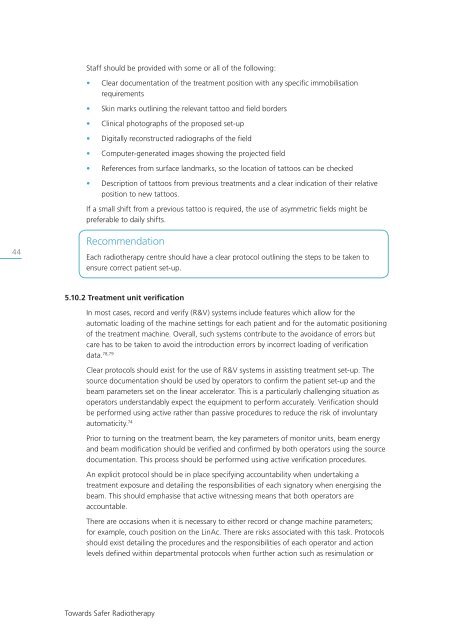Towards Safer Radiotherapy
Towards Safer Radiotherapy
Towards Safer Radiotherapy
You also want an ePaper? Increase the reach of your titles
YUMPU automatically turns print PDFs into web optimized ePapers that Google loves.
Staff should be provided with some or all of the following:<br />
• Clear documentation of the treatment position with any specific immobilisation<br />
requirements<br />
• Skin marks outlining the relevant tattoo and field borders<br />
• Clinical photographs of the proposed set-up<br />
• Digitally reconstructed radiographs of the field<br />
• Computer-generated images showing the projected field<br />
• References from surface landmarks, so the location of tattoos can be checked<br />
• Description of tattoos from previous treatments and a clear indication of their relative<br />
position to new tattoos.<br />
If a small shift from a previous tattoo is required, the use of asymmetric fields might be<br />
preferable to daily shifts.<br />
44<br />
Recommendation<br />
Each radiotherapy centre should have a clear protocol outlining the steps to be taken to<br />
ensure correct patient set-up.<br />
5.10.2 Treatment unit verification<br />
In most cases, record and verify (R&V) systems include features which allow for the<br />
automatic loading of the machine settings for each patient and for the automatic positioning<br />
of the treatment machine. Overall, such systems contribute to the avoidance of errors but<br />
care has to be taken to avoid the introduction errors by incorrect loading of verification<br />
data. 78,79<br />
Clear protocols should exist for the use of R&V systems in assisting treatment set-up. The<br />
source documentation should be used by operators to confirm the patient set-up and the<br />
beam parameters set on the linear accelerator. This is a particularly challenging situation as<br />
operators understandably expect the equipment to perform accurately. Verification should<br />
be performed using active rather than passive procedures to reduce the risk of involuntary<br />
automaticity. 74<br />
Prior to turning on the treatment beam, the key parameters of monitor units, beam energy<br />
and beam modification should be verified and confirmed by both operators using the source<br />
documentation. This process should be performed using active verification procedures.<br />
An explicit protocol should be in place specifying accountability when undertaking a<br />
treatment exposure and detailing the responsibilities of each signatory when energising the<br />
beam. This should emphasise that active witnessing means that both operators are<br />
accountable.<br />
There are occasions when it is necessary to either record or change machine parameters;<br />
for example, couch position on the LinAc. There are risks associated with this task. Protocols<br />
should exist detailing the procedures and the responsibilities of each operator and action<br />
levels defined within departmental protocols when further action such as resimulation or<br />
<strong>Towards</strong> <strong>Safer</strong> <strong>Radiotherapy</strong>



